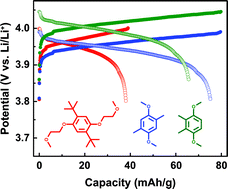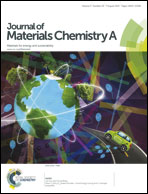A subtractive approach to molecular engineering of dimethoxybenzene-based redox materials for non-aqueous flow batteries†
Abstract
The development of new high capacity redox active materials is key to realizing the potential of non-aqueous redox flow batteries (RFBs). In this paper, a series of substituted 1,4-dimethoxybenzene based redox active molecules have been developed via a subtractive design approach. Five molecules have been proposed and developed by removing or reducing the bulky substituent groups of DBBB (2,5-di-tert-butyl-1,4-bis(2-methoxyethoxy)benzene), a successful overcharge protection material for lithium-ion batteries. Of these derivatives, 2,3-dimethyl-1,4-dimethoxybenzene (23DDB) and 2,5-dimethyl-1,4-dimethoxybenzene (25DDB) are particularly promising as they demonstrate favorable electrochemical characteristics at gravimetric capacities (161 mA h g−1) that approach the stability limit of chemically reversible dimethoxybenzene based structures. Diffusivity, solubility, and galvanostatic cycling results indicate that both 23DDB and 25DDB molecules have promise for non-aqueous RFBs.


 Please wait while we load your content...
Please wait while we load your content...